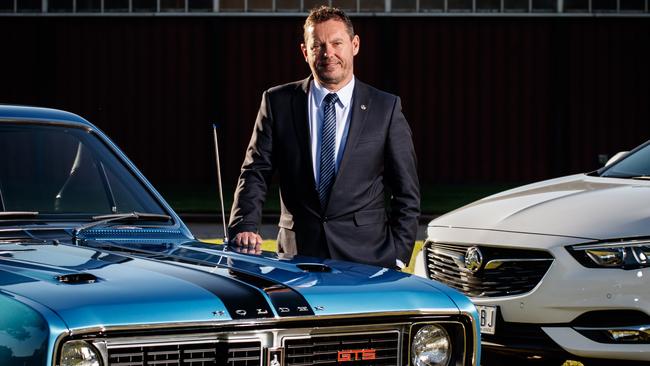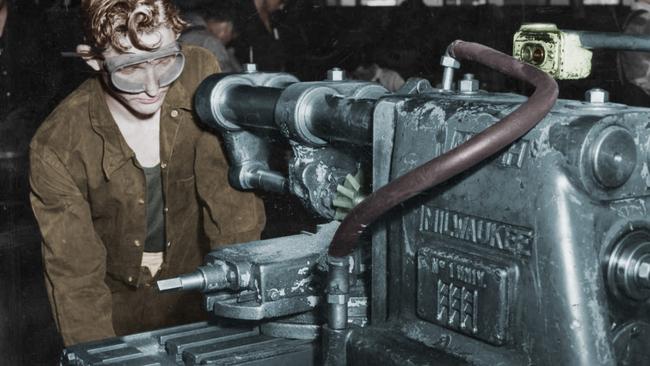When Holden closed its Adelaide factory: The end of a glorious era
For six decades being Australian has meant football, meat pies, kangaroos and home-built Holden cars. Now, the brand is ending for good. We revisit how Chief Reporter Paul Starick covered the winding down of the Adelaide factory in 2017 and optimism for the future.
SA Weekend
Don't miss out on the headlines from SA Weekend. Followed categories will be added to My News.
* Editor's note - this article was originally published in 2017 in The Advertiser's SA Weekend magazine.
Past, present and future suddenly collide as Holden chief Mark Bernhard motors along the Salisbury Highway.
We’re driving in Holden heartland, less than 5km from the Elizabeth car assembly plant which will shut on October 20.
More than half of the remaining 944 employees at Elizabeth live in Adelaide’s north. Most of these — 257 — live in the Salisbury Council area.
We’re in a next-generation Trailblazer SUV, one of the models Holden is pinning its future upon, sweeping past lines of red-brick houses with tiled roofs. These homes date back to the 1960s, when Holden was King of the Road and the bustling Elizabeth plant was considered among the most efficient and productive General Motors factories in the world.
Bernhard, 53, is steeped in this history. One of his earliest memories is sleeping on the back seat of his dad’s blue FJ. A veteran GM finance executive, he volunteered to come home from China in mid-2015 to head Holden. In doing so, he embraced a hefty burden. Bernhard has the heavy responsibility of not only shutting down the Elizabeth plant for the last time on October 20 — he is also shutting the door on Australian car manufacturing.
The genial Bernhard, who sports a neatly cropped beard and closely cut, slightly wavy brown hair, speaks in unassuming, measured and polite tones. He’s just visited the Elizabeth plant and is seizing the opportunity to spruik Holden’s future — importing cars like the all-new Trailblazer SUV — by having a staffer drive us to the airport ahead of his flight home to Melbourne.

Bernhard pauses, at length, when asked what the impact will be when the Elizabeth plant closes on the Salisbury heartland sliding past outside the Trailblazer’s window.
“I’ll need to think about that,” he says, pausing for about 10 seconds.
Then, speaking methodically but his voice laced with emotion, Bernhard declares: “We know from the employee numbers that you saw that these areas are among the most impacted by the closure of Holden. What’s important to us as a business is that we leave a good legacy. It’s really critical for us as a brand but it’s also really important in the way we look after our people.
“These are people who’ve put their hearts and souls into Holden. And looking after them and their families is really important. We’re working actively. We’re working together with the Government but also ourselves in making sure we build up that legacy.”
PODCAST: “AUSTRALIAN AS THEY COME - THAT’S HOLDEN!”
Few companies can claim a domestic legacy as extensively bound into the Australian psyche as Holden. More than 40 years ago, in 1976, Holden famously posed the rhetorical question: “What’s your favourite car, Australia?” The line spearheaded an advertising campaign featuring a montage of outdoor scenes, including cricket and a beach. “We love football, meat pies, kangaroos and Holden cars,” a chanting crowd sang for the signature jingle. It might have been adapted from an American Chevrolet campaign (baseball, hot dogs, apple pie and Chevrolet) but the campaign struck a chord and the tag lines stuck.
But it is Adelaide, in particular, where Holden’s heritage stretches back right to the early days — just 20 years after the first colonists arrived in South Australia in 1836. According to Holden’s official history, the automotive company originated in 1856, when James Alexander Holden set up shop in King William St, Adelaide, as J.A. Holden and Company, suppliers of saddles and leathergoods. In 1878, Holden began manufacturing horse-drawn coaches. By 1919, Holden’s Motor Body Builders was operating from the corner of King William and Gilles streets.
In 1924, Holden became the sole supplier of bodies for General Motors vehicles, when it opened a new production plant in Woodville. A Birkenhead plant opened in 1926, on the shores of Port Adelaide’s inner harbour.
On November 29, 1948, this time at Holden’s Fisherman’s Bend factory in Melbourne, Prime Minister Ben Chifley proclaimed: “She’s a beauty!” as he saw Australia’s first locally made mass production car, the Holden 48-215 — known as the FX — roll off the production line. In an apt tribute, the number one Holden is now on display at Birdwood’s National Motor Museum.
By 1958, the creation of a new Holden manufacturing plant at Elizabeth was a linchpin in long-serving premier Sir Thomas Playford’s industrialisation drive. Foundations were poured that May, in a paddock for which Playford’s officials had to pay a hard-bargaining farmer the princely sum of more than £1030 an acre, before the government could sell it to General Motors.
Fifty years later, in 2008, the Elizabeth plant employed about 3400 people and, the previous year, produced 107,795 cars for domestic and export markets.
It’s an extraordinary homegrown heritage. It’s one that weighs upon Bernhard, so much so that he volunteered to become the first Australian to run the company in 25 years. A 31-year GM Holden veteran, he left a role as GM Shanghai’s chief financial officer to become GM Holden’s chairman and managing director in July, 2015. The Elizabeth plant’s closure had been announced in December, 2013. Bernhard wanted to lead the company through the rocky path ahead.
“I was one of the senior Australians overseas and I felt a responsibility, being Australian, to come back and really treat the employees with dignity and respect,” he says.
“A difficult decision had been made but how we leave the country was really important to me, on a personal standpoint.
“But at the same time, there’s the other aspect of the role, which is setting up the business for the future and honouring the heritage of everyone who’s worked in the business up until October 20.
“You know, you look at the plant today and the employees there are unbelievably passionate. They’re passionate about Holden and they want a legacy for the future as well.”
This enthusiasm until the end is demonstrated by the Elizabeth plant, in recent months, winning a top internal GM award for quality. It is an admirable feat, given the magnitude of the looming closure.
Just as the workers are pressing ahead until the end, a political firestorm, sparked by the 2013 closure announcement, has barely abated. Premier Jay Weatherill has accused the federal Liberals of deliberately undermining Holden in an attempt to shift the blame to the company for closure. In turn, the Liberals have accused Labor of failing to diversify the state’s economy after holding office since 2002. At a meeting with GM officials in Detroit in March last year, Mr Weatherill asked for a $5 million community fund as an act of goodwill.

Inextricably linked to the impact in SA of a global decline in manufacturing, the Holden closure and its aftermath will stalk and shadow the campaign for next March’s state election. For his part, Bernhard is determined to shield employees from becoming pawns in games of pointscoring and repeatedly declines to be drawn on political issues.
He’s proud of Holden’s “transition” centre at Elizabeth, a vocationally focused area in the main administration building which gives workers skills for the future and links them with prospective employees. There’s everything from resume writing lessons to courses on how to use Microsoft Word, Excel and PowerPoint. More than 80 per cent of the workforce is getting a job elsewhere, Holden figures show.
PODCAST: “She’s a beauty!” Myths and legends of the very first Holden
“I think for us as a business, and for me personally coming back to Australia, treating our employees with dignity and respect was one of the key reasons I came back,” he says.
“We need to get on and look after our employees. That’s the most important thing for us. We can’t change what’s happening in federal/state politics so we’ll focus on what we can control.”
For now, that focus is firmly on October 20 and beyond. The final day’s production will test Bernhard’s leadership.
Can he engineer a shutdown that honours Holden’s heritage, respects the workers and suppresses any community anger? Once again, Bernhard pauses thoughtfully, at length, when asked what October 20 looks like and how he will measure success.
“It’s going to be a very emotional day. It’s going to be sad. I’ll shed a tear, as will many people I think,” he says. “At the same time, I also hope that, as a Holden team, we can celebrate the success that we’ve had — pat one another on the back for building great quality cars right until the end.
“And then, move forward, as well. Make sure we honour the legacy of all those people who have to leave us on that day.”

It’s hard to escape the feeling that he’s delivering an obituary for a 123.86ha industrial complex that’s been at the heart of Adelaide’s north for almost 60 years.
But Bernhard must not only manage the shutdown, he must lead Holden into a new era. This involves leveraging the extensive dealer network and selling cars imported from GM’s extensive global suite. The next Commodore, for example is a rebadged and re-engineered Opel Insignia, imported from Germany.
So, if many people will shed a tear on October 20, what does October 21 look like for Bernhard? What happens the day after manufacturing’s demise?
“If I can flip my brain quickly enough from one significant event to the next, it is really about focusing, getting everyone really focused on making sure that what we do as we go forward really honours the legacy of the people who’ve worked for us by building a really bright future for the company,” Bernhard says.
PODCAST: “Just like walking into John Martin’s Cave”. Inside Holden at Elizabeth
In some respects, Holden’s future becomes simpler on October 21. The focus is clear and simple — leverage GM’s global production network, re-engineer cars for Australian conditions and sell them through a large group of Holden dealers around the country.
This dealer network of independently owned businesses has, Bernhard admits, been somewhat underappreciated in the past. But these franchisees are critical to Holden’s future without domestically made cars. They enable Bernhard to disprove the perception that Holden is leaving the country, even if it is abandoning Australian car building.
“I view the (Holden) footprint as being right around the country, because I view the Holden dealers and the employees in the Holden dealers as part of Holden.

“We probably haven’t thought that way in the past but it’s the way we need to think in the future. We’re a significant employer. There’s 5000-10,000 employees right around the country who are as passionate about Holden as I am.”
As if from nowhere, Bernhard suddenly displays hitherto unseen swagger. It’s the sort of confidence that, perhaps, a Holden boss displayed when the company was king of the Australian road.
“Frankly we are an iconic brand and we built the automotive industry here. So we have a lot of history and a lot of heritage with the dealers and the dealership staff as well,” he proudly declares. “We’re all in it together and wanting to succeed.”
This is the challenge before Bernhard; leveraging the Holden history to survive and thrive in the uncharted landscape ahead.
When Bernhard started at Holden in 1986, as a Monash University business accounting degree graduate, he was enthralled by the excitement of an industry about which everyone had an opinion, good or bad. At the time, Peter Brock, in his Holden Dealer Team Commodore, was the King of Bathurst’s mountain, (even if Allan Grice won the famous race that year also in a Commodore).
At the time, homegrown Holdens and Fords dominated the car market. It was yet to fully experience the transformational impact of cheaper imports, wrought through Labor’s 1984 plan to phase out tariffs and make the industry more efficient.
That marked one epoch in Australia’s car industry. Now, with the closure of manufacturing, another is at hand.
Bernhard is keen to draw a continuous line from the mid-1980s, when he started and Holden was strong, to the challenges facing the now fourth-top-selling brand in this new era. “I think the underlying culture of the place is not much different,” he says.
“There was a massive amount of passion around Holden then, amongst the employees, amongst the dealers — and there still is today.
“I don’t think that’s waned. I think our business model’s changed but the passion around the business hasn’t changed at all ...
“The success of the company is going to be demonstrated by how well we take the business and the brand forward.
“If we build a bright future, which is what we certainly plan to do, I think that honours the heritage of the people today and of the business tomorrow.”




